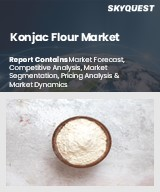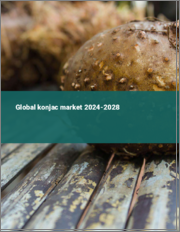
|
시장보고서
상품코드
1616291
곤약가루 시장 기회, 성장 촉진요인, 산업 동향 분석, 예측(2024-2032년)Konjac Flour Market Opportunity, Growth Drivers, Industry Trend Analysis, and Forecast 2024 - 2032 |
||||||
세계의 곤약가루 시장은 2023년에 12억 8,000만 달러에 달하며, 2024-2032년 CAGR 2.6%로 성장할 것으로 예측됩니다.
시장의 최근 성장은 소비자의 인식이 높아지고 건강 지향적인 식물성 식품에 대한 수요가 증가함에 따라 이루어졌습니다. 동남아시아가 원산지인 곤약가루는 식이섬유가 풍부하고 칼로리가 낮은 것으로 알려진 괴경에서 추출하므로 특히 유럽과 미국 시장에서 다이어트 식품으로 인기를 끌고 있습니다. 곤약가루 시장의 세계 동향이 변화함에 따라 소비자의 다양한 기호에 대응하기 위해 혁신적인 제품 배합과 폭넓은 제품 포트폴리오가 중요시되고 있습니다. 제조업체들은 저칼로리 스낵, 무글루텐 구운 식품, 식물성 고기 등 다양한 제품에 곤약가루를 사용하는 등 제품 다양화를 추진하고 있습니다.
이러한 접근 방식은 곤약가루의 범용성과 다양한 기능적 이점을 활용하고자 하는 것입니다. 또한 팬데믹으로 인해 더욱 활발해진 E-Commerce 플랫폼을 활용하여 브랜드 인지도를 높이고 소비자와의 직접적인 소통을 촉진하는 제조업체도 늘고 있습니다. 과거 아시아 중심이었던 곤약가루 시장도 유럽과 미국으로 크게 진출하고 있습니다. 역사적으로 곤약가루 제품의 주요 판매처는 아시아, 특히 일본과 중국이었습니다.
그러나 지난 10년간 북미와 유럽이 매우 중요한 시장으로 부상하고 있습니다. 이는 아시아 음식에 대한 갈망과 더 넓은 세계 음식에 대한 탐구 증가가 원동력이 되고 있습니다. 또한 제조업체들은 케토, 무글루텐, 당뇨병 환자 등 특정 식습관에 맞는 곤약 분말 기반 제품을 혁신적으로 개발하여 다양한 건강 지향적 소비자층에게 어필하고 있습니다. 전체 산업은 등급, 용도, 지역으로 나뉩니다. 곤약 분말 시장의 식품 등급 부문은 2023년 9억 달러로 평가되었고, 2024-2032년 연평균 2.8%의 성장률을 보일 것으로 예상됩니다. 저칼로리, 고섬유질 식품에 대한 소비자의 선호도가 높아지면서 식품용 곤약 분말에 대한 수요가 증가하고 있습니다.
| 시장 범위 | |
|---|---|
| 개시년 | 2023년 |
| 예측년 | 2024-2032년 |
| 개시 가격 | 12억 8,000만 달러 |
| 예상 가격 | 16억 1,000만 달러 |
| CAGR | 2.6% |
곤약가루는 증점제, 안정제, 지방 대체제로서 면류, 파스타, 구운 식품, 음식 및 음료 등 다양한 식품에 함유되어 있으며, 2023년 8억 8,000만 달러로 평가되었고, 음료 및 식품 부문 곤약 분말 시장은 2024-2032년 연평균 2.8%의 연평균 복합 성장률(CAGR)로 성장할 것으로 예상됩니다. 음료 및 식품 부문에서는 건강하고 저칼로리, 식물성 식품을 선호하는 소비자가 증가함에 따라 곤약가루의 활용이 증가하고 있습니다. 곤약가루는 저탄수화물 국수, 파스타, 쌀밥 제조에 매우 중요한 역할을 하고 있으며, 케토제닉 다이어트와 무글루텐 다이어트 증가 추세와도 잘 맞아떨어지고 있습니다. 북미 곤약 분말 시장은 2023년 3억 4,000만 달러 규모로 연평균 2.7% 성장할 것으로 예상됩니다. 이 시장의 꾸준한 성장은 저칼로리, 무글루텐, 식물성 식품에 대한 수요가 급증하고 있기 때문입니다. 미국과 캐나다에서는 건강 지향적인 소비자들이 기존 밀가루보다 곤약가루를 선호하고 있는데, 그 이유는 섬유질이 풍부하고 탄수화물이 적기 때문입니다.
목차
제1장 조사 방법과 조사 범위
제2장 개요
제3장 산업 인사이트
- 에코시스템 분석
- 주요 제조업체
- 유통업체
- 산업 전체의 이익률
- 산업에 대한 영향요인
- 촉진요인
- 시장이 해결해야 할 과제
- 시장 기회
- 새로운 기회
- 성장 가능성 분석
- 원료 상황
- 제조 동향
- 기술의 진화
- 지속가능 제조
- 그린 프랙티스
- 탈탄소화
- 지속가능 제조
- 원료의 지속가능성
- 가격 동향(달러/톤), 2021-2032년
- 규제와 시장에 대한 영향
- Porter의 산업 분석
- PESTEL 분석
제4장 경쟁 구도
- 기업 점유율 분석
- 경쟁 포지셔닝 매트릭스
- 전략 전망 매트릭스
제5장 시장 규모·예측 : 등급별, 2021-2032년
- 주요 동향
- 식품 등급
- 의약품 등급
- 산업용 등급
제6장 시장 규모·예측 : 용도별, 2021-2032년
- 주요 동향
- 식품 및 음료
- 의약품과 뉴트라슈티컬
- 화장품·퍼스널케어
- 기타
제7장 시장 규모·예측 : 지역별, 2021-2032년
- 주요 동향
- 북미
- 미국
- 캐나다
- 유럽
- 독일
- 영국
- 프랑스
- 이탈리아
- 스페인
- 기타 유럽
- 아시아태평양
- 중국
- 인도
- 일본
- 한국
- 호주
- 기타 아시아태평양
- 라틴아메리카
- 브라질
- 멕시코
- 아르헨티나
- 기타 라틴아메리카
- 중동 및 아프리카
- 사우디아라비아
- 아랍에미리트
- 남아프리카공화국
- 기타 중동 및 아프리카
제8장 기업 개요
- Henan Sinowin Chemical Industry Co.,Ltd
- AVANSCHEM
- Baoji Konjac Chemcial Co.,Ltd
- Chemcopia
- Fengchen Group Co.,Ltd
- FMC Corporation
- GreenFresh(Fujian) Food stuff co.,ltd
- GreenSkyBio
- KONSON KONJAC
- SARDA Bio Polymers PVT. LTD
- Marine Hydrocolloids
The Global Konjac Flour Market was valued at USD 1.28 billion in 2023 and is projected to grow at a 2.6% CAGR from 2024 to 2032. The market's recent growth can be attributed to increasing consumer awareness and a rising demand for health-focused, plant-based foods. Originating from Southeast Asia, konjac flour is derived from a tuber known for its high fiber content and low caloric value, making it a popular choice in dietary products, especially in Western markets. As global business trends in the Konjac flour market shift, there is a pronounced emphasis on innovative product formulations and a broader product portfolio to cater to varied consumer preferences. Manufacturers are diversifying their offerings, prominently featuring konjac flour in products like low-calorie snacks, gluten-free baked goods, and plant-based meats.
This approach seeks to capitalize on Konjac flour's versatility and its numerous functional advantages. Additionally, manufacturers are increasingly turning to e-commerce platforms, a trend that gained momentum during the pandemic, enhancing brand visibility and facilitating direct consumer engagement. Once predominantly rooted in Asia, the Konjac flour market is making significant inroads into Western territories. Historically, konjac flour products found their primary audience in Asia, notably in Japan and China.
However, over the past decade, North America and Europe have emerged as pivotal markets, driven by a growing fascination with Asian cuisine and a broader global culinary exploration. Furthermore, manufacturers are innovating and developing konjac flour-based products that cater to specific dietary preferences, including keto, gluten-free, and diabetic-friendly options, appealing to a diverse and health-conscious demographic. The overall industry is divided into grade, application, and region. The food-grade segment of the Konjac flour market was valued at USD 900 million in 2023 and is projected to grow at a CAGR of 2.8% from 2024 to 2032. The rising consumer shift towards low-calorie, high-fiber foods has spurred demand for food-grade konjac flour.
| Market Scope | |
|---|---|
| Start Year | 2023 |
| Forecast Year | 2024-2032 |
| Start Value | $1.28 Billion |
| Forecast Value | $1.61 Billion |
| CAGR | 2.6% |
Renowned for its functions as a thickening agent, stabilizer, and fat replacer, konjac flour is incorporated into a wide array of food products, such as noodles, pasta, baked goods, and beverages. Valued at USD 880 million in 2023, the Konjac flour market within the food and beverages segment is set to grow at a CAGR of 2.8% from 2024 to 2032. The food and beverage sector is increasingly utilizing konjac flour, driven by a growing consumer preference for healthy, low-calorie, and plant-based choices. Konjac flour plays a pivotal role in producing low-carb noodles, pasta, and rice, aligning seamlessly with the rising trends of ketogenic and gluten-free diets. North America Konjac flour market was valued at USD 340 million in 2023 and is projected to grow at 2.7% CAGR.The market's steady growth is driven by a burgeoning demand for low-calorie, gluten-free, and plant-based food items. Health-conscious consumers in the U.S. and Canada are increasingly favoring konjac flour over traditional wheat flour, attributing this preference to its high fiber and low carbohydrate content.
Table of Contents
Chapter 1 Methodology & Scope
- 1.1 Market scope & definition
- 1.2 Base estimates & calculations
- 1.3 Forecast calculation
- 1.4 Data sources
- 1.4.1 Primary
- 1.4.2 Secondary
- 1.4.2.1 Paid sources
- 1.4.2.2 Public sources
Chapter 2 Executive Summary
- 2.1 Industry 360° synopsis
Chapter 3 Industry Insights
- 3.1 Industry ecosystem analysis
- 3.1.1 Key manufacturers
- 3.1.2 Distributors
- 3.1.3 Profit margins across the industry
- 3.2 Industry impact forces
- 3.2.1 Growth drivers
- 3.2.2 Market challenges
- 3.2.3 Market opportunity
- 3.2.3.1 New opportunities
- 3.2.3.2 Growth potential analysis
- 3.3 Raw material landscape
- 3.3.1 Manufacturing trends
- 3.3.2 Technology evolution
- 3.3.2.1 Sustainable manufacturing
- 3.3.2.1.1 Green practices
- 3.3.2.1.2 Decarbonization
- 3.3.2.1 Sustainable manufacturing
- 3.3.3 Sustainability in raw materials
- 3.3.4 Pricing trends (USD/Ton), 2021 - 2032
- 3.3.4.1 North America
- 3.3.4.2 Europe
- 3.3.4.3 Asia Pacific
- 3.3.4.4 Latin America
- 3.3.4.5 Middle East & Africa
- 3.4 Regulations & market impact
- 3.5 Porter's analysis
- 3.6 PESTEL analysis
Chapter 4 Competitive Landscape, 2023
- 4.1 Company market share analysis
- 4.2 Competitive positioning matrix
- 4.3 Strategic outlook matrix
Chapter 5 Market Size and Forecast, By Grade, 2021-2032 (USD Million, Tons)
- 5.1 Key trends
- 5.2 Food grade
- 5.3 Pharmaceutical grade
- 5.4 Industrial grade
Chapter 6 Market Size and Forecast, By Application, 2021-2032 (USD Million, Tons)
- 6.1 Key trends
- 6.2 Food and beverages
- 6.3 Pharmaceuticals and nutraceuticals
- 6.4 Cosmetics and personal care
- 6.5 Others
Chapter 7 Market Size and Forecast, By Region, 2021-2032 (USD Million, Tons)
- 7.1 Key trends
- 7.2 North America
- 7.2.1 U.S.
- 7.2.2 Canada
- 7.3 Europe
- 7.3.1 Germany
- 7.3.2 UK
- 7.3.3 France
- 7.3.4 Italy
- 7.3.5 Spain
- 7.3.6 Rest of Europe
- 7.4 Asia Pacific
- 7.4.1 China
- 7.4.2 India
- 7.4.3 Japan
- 7.4.4 South Korea
- 7.4.5 Australia
- 7.4.6 Rest of Asia Pacific
- 7.5 Latin America
- 7.5.1 Brazil
- 7.5.2 Mexico
- 7.5.3 Argentina
- 7.5.4 Rest of Latin America
- 7.6 MEA
- 7.6.1 Saudi Arabia
- 7.6.2 UAE
- 7.6.3 South Africa
- 7.6.4 Rest of MEA
Chapter 8 Company Profiles
- 8.1 Henan Sinowin Chemical Industry Co.,Ltd
- 8.2 AVANSCHEM
- 8.3 Baoji Konjac Chemcial Co.,Ltd
- 8.4 Chemcopia
- 8.5 Fengchen Group Co.,Ltd
- 8.6 FMC Corporation
- 8.7 GreenFresh(Fujian)Food stuff co.,ltd
- 8.8 GreenSkyBio
- 8.9 KONSON KONJAC
- 8.10 SARDA Bio Polymers PVT. LTD
- 8.11 Marine Hydrocolloids














